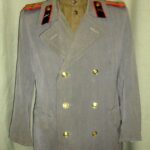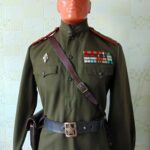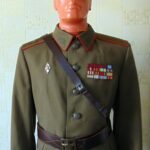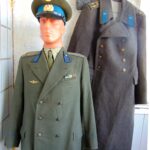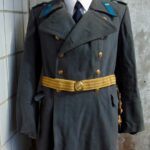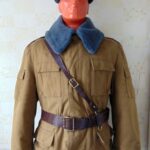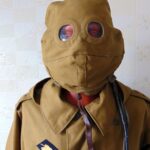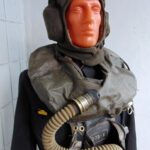The Cold War brief history, the important events, the virtual museum, the artifacts and photos archive. Prepared by M. Blinov* to support the work of collectors, scholars, and the
– Army Museum (Les Invalides Paris, France)
– Tank Museum (Saumur, Loire Valley, France)
– Air and Space Museum at Le Bourget
– Cold War Museum (Warrenton, USA)
Cold War Guide Introduction.
This guide is intended to provide a central reference source for the Cold War collection, containing a basic history of the Cold War (1945-1991) as it pertains to the collection, followed by sections on specific Cold War events so as to provide context for special items in the collection. The guide was prompted by the need to describe items from the author’s collection and to assist in developing the Russian/Soviet sections of the museums listed above. Impetus also came from plans for a large new Cold War exhibition at the Museum of the Army of the Invalides in Paris. Some sections of the guide are presented briefly, others in more detail in accordance with the needs of the relevant museums. This guide can also be used as a guide to the uniforms of the Soviet Army and the NKVD-KGB for collectors and museum workers.
This guide is regularly being updated with new sections, stay tuned for updates. When complete, this guide will cover:
– Prehistory of the Cold War: Lenin, Trotsky, Stalin. WW1 and revolution.
– The Second World War: WW2 Allies against Hitler.
– Cold War, the main periods and the events
– Local wars and conflicts. Special operations abroad
– Uniform and insignias of the Soviet Army, NKVD-MGB-KGB
– Photo archive: the events, vehicles, uniforms, personalities
– Personalities, name index and biographies.
The Start of the Cold War, 1945-1948
There are no exact dates for the beginning of the Cold War, but British Prime Minister Winston Churchill’s March 5, 1946 “Iron Curtain” speech at Westminster College in Fulton, USA, is often considered as the formal start of the period. Churchill, in the presence of US President Truman, outlined the political situation after the Second World War. Following victory over Germany in World War 2, the Western Allies felt threatened by the Soviet Union. Already the division of Germany had created a line across Europe between a democratic West and a communist East, a line Churchill would coin in his speech as the “Iron Curtain.” In reality, the Cold War began a little earlier, in the spring of 1945.On the initiative of Churchill, a plan for war with the USSR, Operation “Unthinkable”, was developed before the German surrender. According to this plan, Russian and Slavic collaborators with Nazi Germany such as anti-Soviet armed formations of the KONR (ROA, Cossacks and national units) could possibly be used against the USSR. Using military and political pressure on the “allies”, Stalin forced the Yalta agreements to be partially fulfilled, and in the summer of 1945, 2 out of 3 Cossack corps (collaborators) were issued to the Soviets, and later also parts of collaborationist General Vlasov’s ROA. Many old and new Russian immigrants to the US, including former collaborators, were recruited into the US military and intelligence agencies. According to available documents, plans to create an ex-auxiliary army for the liberation of the USSR from Russian military émigrés date back to 1953. See “Cossacks, the Russian Protective Corps and the ROA after the Second World War” for more details.
On September 7, 1945, a military parade of the “allies” took place in Berlin, which was attended by the military-political leadership of the victorious countries. The parade’s finale were 52 never-before-seen Soviet IS-3 heavy tanks (Named after Joseph Stalin) that had just entered service with the Soviet 2nd Guards Tank Army. The sudden appearance of mass numbers of new Soviet heavy tank designs rumbling through Berlin greatly surprised and alarmed Churchill, who was in attendance. According to legend, Churchill dropped his smoking pipe, opened his mouth and said that there would be another world war. These IS-3 heavy tanks were in service with the USSR and then Russia until 1998. (The last case of combat use was in 2014 in the war in Ukraine, when the breakaway Donetsk People’s Republic army used an IS-3 tank reactivated from a WWII monument. The main gun was deactivated, but a modern machine gun was installed, and the tank was used as an offensive weapon against the Ukrainian army.)
Immediately after the Second World War, the Soviet Union developed heavy tanks to capture continental Europe, as well as floating tanks to capture Great Britain, as their main offensive weapons in a possible confrontation with the West. Continuing the “tradition” of the Second World War, there was an increase in the armor and caliber of tank guns. After the successful creation of the IS-3 heavy tank, the USSR increased its armor, and the tanks became heavier. Very heavy IS-4 and IS-7 tanks were created, experimental samples of which have survived to this day in the museum at Kubinka. The increase in the mass of the tanks had a bad effect on their maneuverability. Therefore, after testing the Russian military settled on the IS-10. Following the death of Joseph Stalin in 1953 and new First Secretary and Premier Nikita Kruschchev’s subsequent De-Stalinization, the tank was renamed T-10. In total, more than 1000 T-10 tanks and more than 1000 T-10M tanks with Nuclear, Biological, and Chemical (NBC) protection were manufactured to capture Europe in the “special period” (local conflict or World War 3). This tank armada, ready to push to Paris and the English Channel in a nuclear war scenario with the West, was in service with the Soviet army until 1998.
- Artillery & Assault Gun colonel uniform, Hungary Budapest 1956 (author’s collection)
- Soviet army uniform, AV marshal M1959 (Saumur tank museum)
- Tank unit major-general field uniform M1969 (Saumur museum)
The Cold War Solidifies, 1949-1960
The Soviet development of nuclear weapons in 1949, aided by espionage of the American Manhattan Project, led to the further development of long-range bombers as the main means of delivering a new type of weapon. The training of specialists for the future “Third World War” began in the combined arms and air force academies. In the same year, a new and original uniform for aviation and tank units was introduced. In 1955, the new uniform was introduced in all branches of the Soviet military and is unofficially called “Zhukovka” in honor of the Minister of Defense Marshal Zhukov.
In 1954, military exercises using nuclear weapons were held at the Totsk training ground under the leadership of Zhukov. The results of the nuclear weapons effects on soldiers and officers remain classified to this day. Under Khrushchev, a massive reduction in the size of the army and ground forces began, as the new political leader recentered Soviet defense policy on missiles and nuclear weapons.
In 1956, there was a harsh suppression of the uprising in Hungary under the leadership of Marshal Zhukov. In the suppression of the uprising, in addition to the Soviet army, militaries from the various Soviet-Bloc Warsaw Pact countries also took part.. As a result of the Hungarian Uprising, changes were made to the design of the Soviet BTR-152 (the appearance of an armored roof), as well as elements of the 1954 field uniform. Beginning in 1959, all gold epaulets and shiny buttons were replaced by field khaki. The new full dress and everyday uniform, introduced in 1954, largely remained unchanged, except for pilots and tankers.
The creation by communist Moscow of megaton-range thermonuclear weapons and the construction of missile ranges prompted US President Eisenhower’s 1955 proposal to Khrushchev to create an “open skies” system of mutual unarmed aerial overflights of the US and Soviet Union. Khrushchev rejected this proposal; Eisenhower responded by reluctantly authorizing overflights of the Soviet Union by the newly developed Lockheed U-2 high altitude spy plane. . Soviet air defense systems could detect the U-2, but could not destroy them. The Soviets began to develop high-altitude interceptor aircraft and anti-aircraft missile systems to counter the U-2.
In 1957, the Soviets launched the first artificial satellite, Sputnik. Sputnik was launched as part of a larger program to develop a nuclear-armed missile with intercontinental range so as to strike the United States. The world’s first cosmonaut Yuri Gagarin flew aboard an rocket that could also be used to deliver a nuclear bomb, as well as a first-generation space photo reconnaissance satellite of the “Zenith” series. The USSR began to actively build test sites for launching strategic missiles (RVSN) and military satellites.
On May 1, 1960, a U-2 under the control of pilot Francis Gary Powers made a reconnaissance flight intending to fly over central Asia and Urals from Pakistan to Norway. Instead, he was shot down by a new S-75 missile system over Sverdlovsk. May 1, the Soviet communist holiday, the festive mood among the command staff and incomplete air defense crews. Interceptor aircraft and missile systems were both involved in the operation to shoot down Powers, with poor coordination. An Su-9 aircraft, which was unarmed, was supposed to destroy the U-2 with a ram, but received incorrect coordinates. The S-75 missile battery fired three missiles. Two malfunctioned, but the third successfully detonated behind Power’s U-2. The plane broke up in flight, which confused Soviet radar operators who thought the spray of metal shrapnel was Powers deploying chaff as a radar countermeasure. The operators considered it to be continuing its flight and fired a second volley of missiles. One of these missiles shot down a Soviet MiG-19 interceptor aircraft piloted by Captain Sergei Safronov, who had been scrambled so quickly that his plane lacked that day’s codes identifying him as a friendly aircraft.
After the chaos and poor performance of the air defense units, many officials from the Ural Military District, the Air Defense Headquarters and the Operational department of the General Staff were dismissed from service. Powers survived the shoot down, and would be brought on trial for espionage shortly after in a humiliation for the United States, who originally denied that any such over flight ever occurred. One of the expert witnesses for the prosecution was Colonel Fedor Teteryadchenko, a GRU specialist in American aerial reconnaissance platforms.
- HQ colonel Teteryadchenko everyday uniform, 1960 (Cold War Museum USA)
- Colonel Teteryadchenko uniform for Feb 23 & November 7 celebration* 1960 (CWM USA)
- Colonel Teteryadchenko field uniform in 1960, same as Major Voronov, commander of the Missile Battery that shot down Francis Gary Powers
The Cuban Missile Crisis, 1962
In 1962, the Cuban Missile Crisis occurred, which almost ended in a nuclear war. In 1959, the USSR deployed R-5 medium-range ballistic missiles In the GDR, which created a threat to NATO. In 1961, the United States responded by deploying medium-range Jupiter missiles in Turkey, whose flight time to strategic targets in the USSR was much shorter than the ballistic trajectory flight time for missiles launched from the United States. In response, Khrushchev secretly deployed Soviet missiles with R-12 and R-14 nuclear warheads in Cuba. The Cuban government of Fidel Castro was an ally of Moscow’s communists, and already had a contingent of Soviet troops on its territory. During the two-week Crisis, reconnaissance aircraft and submarines were used in tense confrontations, and the troops were put on full alert. War was barely avoided with a last-minute compromise decision to remove the Soviet missiles from Cuba in exchange for the US removing their Jupiter missiles from Turkey. Castro was furious at the apparent betrayal of Cuba, having been excluded from the deal making between the US and the USSR.
With the mass reduction of the ground forces in the post-Stalin years, Khrushchev began to actively promote the Strategic Rocket Forces (RVSN) as an alternative. Professional officers of the missile forces were trained in military schools, and graduates of civilian technical universities were also drafted into the army. Systems of silo-based launchers (“points”) were created, as well as hardened command posts. I would especially like to single out the 50th Smolensk Army of the Strategic Missile Forces, stationed in Western Russia and in Belarus, headquartered in Smolensk. In Moscow, on the basis of the metro system, “Spare command posts” began to appear, more than 100 in total, as well as Metro-2, a system of high-speed secret metro lines from Moscow to secret bunkers and command posts of military branches.
The Prague Spring and Proxy Conflicts, 1968-1989
In 1968, the USSR crushed the uprising in Prague in Operation “Danube”. A special role was played by the Airborne units (VDV) and the secret groups of KGB officers who arrived in advance as “tourists”.
After the suppression of the Prague Spring, in 1969 a new uniform was introduced that was more comfortable during military operations. The American experience of military operations in Vietnam was also taken into account, including the impacts of fire and napalm. In the old 1943 model uniform (tunic), the removal of burning clothes took place through a narrow opening for the head, which made the process long and dangerous. The new uniform provided for a tear along the front buttons in an emergency to allow for a quick “crawling out” of burning clothes.
The paratroopers (“Uncle Vasya” units, General Vasily Margelov) were intensively developed and trained in order to capture and destroy important objects in the event of a “special period”, primarily in Europe. So, for example, the 103rd Airborne Division from Belarus was supposed to take to the air, parachute and destroy military bases in France where missiles with conventional and nuclear warheads were located. Systems for dropping military equipment (tanks and self-propelled guns) with crews inside were developed, a risky prospect. General Margelov tested this system on his son (successfully), the French tested it on a prisoner (crashed). Airborne exercises were conducted and plans were made to capture Europe throughout the 1970s. However, in 1979 the 103rd division was transferred to Afghanistan along with border troops and other units.
The experience of capturing Amin’s palace (The seizure of which kicked off the Soviet-Afghan War) showed that it was necessary to train special units for work abroad. The destruction of military facilities in France would be a “one-way-ticket” for the airborne soldiers. Without knowledge of the French language, the surviving conscripts would have to “go into the forest, into the partisans”, as during the Second World War. Recruiting from the regular servicemen of the KGB border troops, as well as saboteurs and KGB officers, the “Vympel” (Pennant) group was created in 1981 under the “C” department of the First Main Directorate of the KGB. The group was the successor of the work of the “Express” team of the INO NKVD** under the leadership of Yakov Serebryansky, and then Pavel Sudoplatov, who committed sabotage in France in the 1920s and 30s. The group is intended for sabotage and special operations abroad in all countries of the world. The training of the employees of the “Vympel” group lasted almost 5 years and included mountaineering, diving, mining, hand-to-hand combat, parachuting, and proficiency with many different types of weapons. A major task was to deliver a portable nuclear bomb (one 16 kg or 4×16 = 64 kg) to destroy vital facilities. Unlike the soldiers of the Airborne Forces, the “Vympel” fighters were fluent in foreign languages and knew the country where they needed to work. French was considered one of the main languages, as it was a common language in Africa and former French Colonies”. In Angola, for example, “Vympel” group fighters served as Soviet instructors (advisers) and used the uniform of the Cuban army.
The participation of Soviet troops in local wars and conflicts, in Vietnam, in the Arab-Israeli wars, in Africa and Latin America are all also part of the Cold War, but they will be written about separately, as well as other secret special operations abroad.
- New experimental “Afghanistan” field winter uniform, 1980s (Saumur tank museum)
- Driver’s mask against the wind over a tank helmet (Saumur museum)
We single out the war in Afghanistan especially, as it has many different features to be examined. It is especially necessary to note the great variety and mixing of the uniforms of the Soviet troops in Afghanistan. Even in one group of 10 people (squad), we see the 1969 model uniforms in both regular and summer versions, the new one, called “Afghan” or “experimental”, and a wide variety of technical clothing and special-purpose clothing. Special Forces soldiers were very fond of light and comfortable uniforms for helicopter maintenance, receiving as a friend gift or for vodka (the traditional form of currency in the Soviet army). The technical uniform of pilots in Afghanistan served as a prototype for the creation of a special Special Forces uniform under the unofficial name “Mabuta” (named after the African dictator). This uniform was made of lightweight material, had no identification marks and served in unofficial operations abroad. In Afghanistan, Chinese-made trophy ammunition and grenade unloading belts, jokingly called the “Afghan Women’s Bra”, were also used. By the end of the 1980s, the Soviet analogues “Belt A” and “Belt B” were made in small quantities. Instead of heavy boots, known as “sapogi”, foreign Adidas-type sneakers were massively used during the operations in Afghanistan.
Chernobyl and Beyond
Important events of the Cold War era include the 1986 accident at the Chernobyl nuclear power plant. The liquidation of the accident was carried out by the army and “Civil Defense Troops” (GO). During the work, the servicemen used the new, “Afghan” uniform with patch pockets, a dosimeter in their pocket, and a respirator on their face. Most information collected on the effects of the Chernobyl radiation on humans is still classified.
The experience of liquidating the Chernobyl accident resulted in changes to Soviet uniforms in the event of an offensive by Soviet troops on French / NATO territory after the use of nuclear weapons. Instead of the usual OZK (Army Protective Kit) made of dust and moisture-proof rubber, it was planned to wear cotton protective jackets and trousers over the usual uniform, which are more comfortable in hot conditions.
A conventional offensive into Europe, pushing as far as Paris and the English Channel during WW3, was planned every year since the end of the Second World War. To do this, exercises were periodically held using troops and tanks on terrain similar to the European Theater of Operations. The officers were trained in the offensive operations of tanks in Europe by teachers at the Academy of the Armored Forces (Moscow). Periodically, “command and staff exercises” took place, where Paris would be captured by Soviet tanks in map-based war games. In addition to the heavy T-10M tanks, which can go on the attack even after the use of tactical nuclear weapons, there were light amphibious PT-76 tanks. During World War II, the US and British armies lost a large number of tanks during the D-Day landings in Normandy.. Waves and enemy fire were the main causes of losses, so Soviet engineers developed amphibious tanks with this sad experience in mind. Soviet amphibious tanks were supposed to land under enemy fire in Great Britain, crossing from the English Channel, or on the Black Sea on the shores of Turkey, a NATO country.
- Insulating gas mask (air generator) for saving the crew of tanks gone under water, 1980s (author’s collection)
With the collapse of the USSR, great changes took place, the Cold War was transformed into local wars between the former republics of the USSR, and what is now happening is what is already being called “Cold War v.2.0”
Personalities:
- Blinov Yury, lieutenant colonel, Chernobyl Duty Commander
- Lukashenko Vladimir, colonel, the leading tank instructor of the USSR
- Pankratov Lev, general, Deputy Chairman of the KGB
- Teteryadchenko Fedor, colonel, aviation, General Staff

